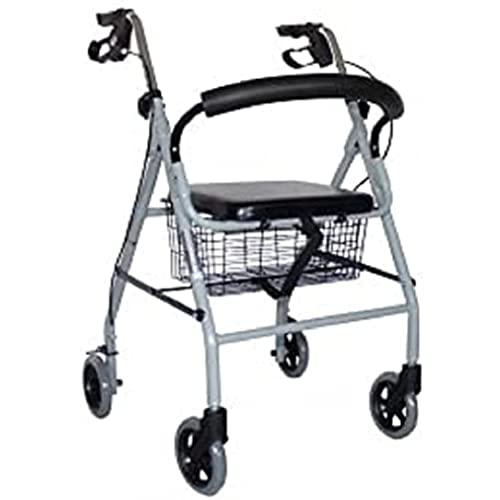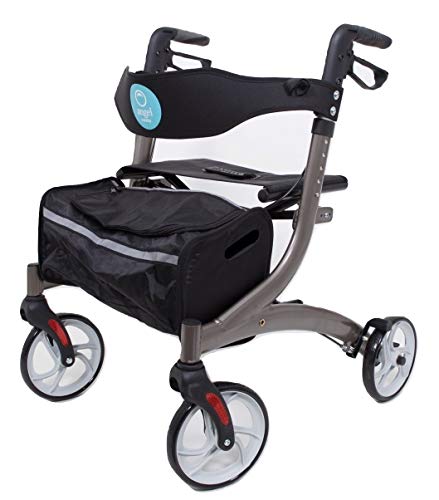What's The Job Market For Small Rollator With Seat Professionals Like?
관련링크
본문
 Small rollator with seat (https://pattern-wiki.win/wiki/A_Productive_Rant_Concerning_Rollators_With_Seats)
Small rollator with seat (https://pattern-wiki.win/wiki/A_Productive_Rant_Concerning_Rollators_With_Seats) A small rollator is a tool for mobility that allows you to walk comfortably. They typically include four wheels, a chair, and locking loops hand brakes.
A small rollator is a tool for mobility that allows you to walk comfortably. They typically include four wheels, a chair, and locking loops hand brakes.They fold up into a compact size, so they can fit into the trunk of your car or the overhead bin of an airplane.
Increased Mobility
A small rollator with seat can make a significant difference in the mobility of those who must move quickly. They assist in getting people from one place to another faster than standard walkers, and they often maneuver better in tight spaces because of their compact design.
The foldable models that are light can be transported in the trunk, or in the backseat of a vehicle. Many of these units come with hand brakes for added stability and security. This kind of aid for mobility is beneficial for those suffering from arthritis, fibromyalgia or other chronic illnesses that affect stability and balance.
These buy rollators with seats are lighter than bariatric models due to their smaller size. They range in weight from 10 pounds to 15 pounds making them ideal for travel. They can also be folded up and put away when not in use, which will save space at home or when on the go.
Small rollators with seats have built-in chairs that allow users to sit down when they require. This can help reduce fatigue on long walks and gives the user the opportunity to take a break from the walking they're doing. Certain models, like the EZ Fold-N-Go, even offer an organizer pouch in the front, as well as two storage bags for additional convenience.
The brake and wheels on these mobility aids can also help in conserving energy, as they won't require nearly as much force like a traditional walker. This helps to prevent the user from tiring out fast, and it can also aid in reducing accidents because they don't have to constantly lift up and putting down their mobility aids.
These small mobility aids also have the capacity of carrying a heavier weight than standard walkers. This is because they don't need to support all of the weight of the user while moving forward or backwards. This can improve stability and prevent the user from falling or falling over while going up or down stairs, or over uneven terrain.
Stamina Increased
Rollators allow you to take breaks from walking whenever necessary, improving endurance and reducing fatigue. This is particularly beneficial for people who are unable to hold a traditional walker or need an area to rest and sit on long journeys. Some rollators also come with a backrest to provide an additional level of support while sitting.
While the main features of the rollator are determined by its weight and size capacity, there are many options to add accessories to personalize the user's experience. For example, side bags and baskets are able to assist in storing and transporting items frequently utilized when away from home like food, drinks or prescription medications. This reduces the need to take a risk of falling by reaching overhead or from behind to retrieve an object which can cause frustration and discomfort for the user.
The ergonomic design of a handle on a rollator contributes to its user-friendliness as well. Handles that are well-positioned and comfortable to use are crucial for those with arthritis or weak muscles in their hands. Many rollator models have height-adjustable handlebars which can be set to different positions to suit the individual's requirements. This feature is especially useful for those with shoulder or arm injuries. It can reduce the strain that comes from bent over to pick something up from the floor.
Stability and maneuverability are also important considerations when choosing a rollator. A reliable rollator should be able to maintain its position and not tilt or shift while being pushed, and should have brakes that are easy to engage and disengage. The tight turning radius of a rollator could allow it to be maneuvered in cramped areas, like an aisle that is narrow in a grocery store.
Some models of rollator have been designed to be carried by the user. They are lightweight and foldable. They can be easily put into a trunk or the back seat of a car, and then folded up when it's time for walking again. They are also perfect to take on public transport, since they can be folded and put away in the compartment for luggage or above the seat.
Convenience
A small rollator that has a seat is a good option for users who have mobility issues that are beyond the scope of the walking cane or walker. These aids can help people with balance and mobility problems regain their independence. However, they are often too heavy for those who require greater flexibility. These smaller and narrower walkers, also known as petite or compact rollators or junior walkers, are optimized to meet the requirements of those who are small and have a range of features that make them more suitable to use in everyday life than their larger counterparts.
These special-purpose walking walkers have smaller frames and wheels and they can maneuver more easily in tight spaces than standard models of the same size. Some models have built-in seating that allow people to relax and sit to increase their endurance by giving them the ability to break up long walks into smaller segments. These specialized walker models are also light, which makes them easier for people to travel with. They are able to be easily tucked away in the trunk or backseat of cars.
A lot of walker models come with various accessories that can be purchased separately, including things such as baskets and bags for carrying under the seat (three wheel rollator with seat wheel rollators usually include them between the rear wheels). These accessories allow users to easily carry food, drinks or other items on their device. Attachments that help keep hands free are available, including cup holders and oxygen tank holders for those who need a little extra help breathing.
There are also small walker-rollers for those who prefer a minimalistic approach to mobility. These have no seat, but only an arm-rest to which the user can hold their arms. They're not as effective, but they can be beneficial to those who have difficulty standing on their feet or carrying heavy objects that would otherwise weight down a standard model walker. These walker roll models also tend to be cheaper than standard walker models making them more accessible for those with a tight budget.
Safety
A small rollator that has a seat is a convenient and safe mobility aid for those who need assistance with getting around. It helps them stay on their feet longer which decreases the risk of falls and injuries. The cushioned seat offers comfort and support for the user. This makes it easier for them to walk longer distances. It also lets them lay down and rest if they're tired. Look for locking brakes, a lighter design, and other security features.
Certain manufacturers provide additional accessories that can enhance the comfort and ease of use like an accessory basket for storage or a pouch in front of the seat. These accessories allow users to easily store personal items that are easy to access while using the rollator. This makes walking safer as it reduces the need to bend and reach for items. Some models come with a folding mechanism which allows the device to fold into a car trunk or bag when not when not in use.
The size of the wheels is important when selecting a small rolling chair with a seat. Smaller wheels, typically 6" or 7", provide a tighter turning radius and are suitable for indoor use. Larger wheels, on the contrary, provide an easier ride for outdoor use on rough or uneven terrain.
Safety is another consideration when it comes to handle height. The majority of rollators have an adjustable handle height that can be adjusted to suit the requirements of different users. Stand straight up in your shoes and take a measurement from the floor to the center of your wrist.
A good guideline is to select a handle height that allows you to push the wheels of your rollator without having to strain or bend your arms too much. Once you have selected the correct height for your handle, lock the brakes on your rollator before you attempt to sit down. You can unlock the brake levers when sitting to alter the speed, but make sure not to release them until you are standing again.

